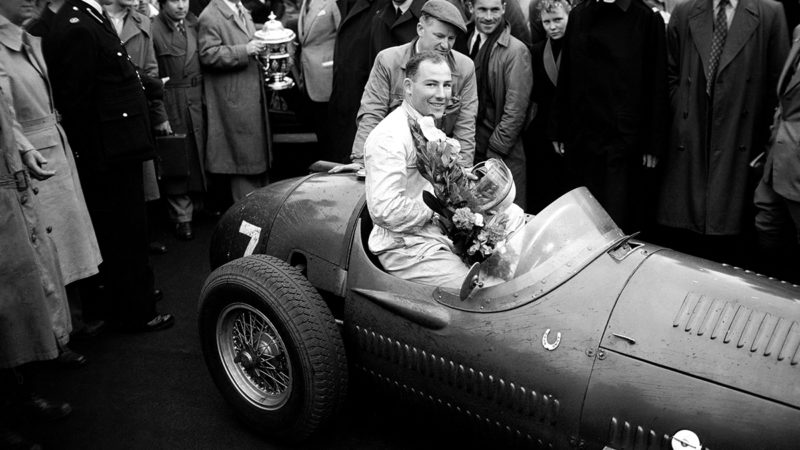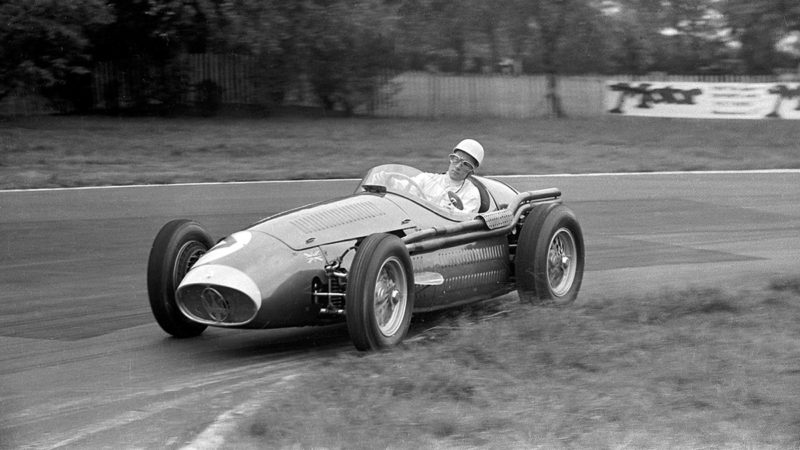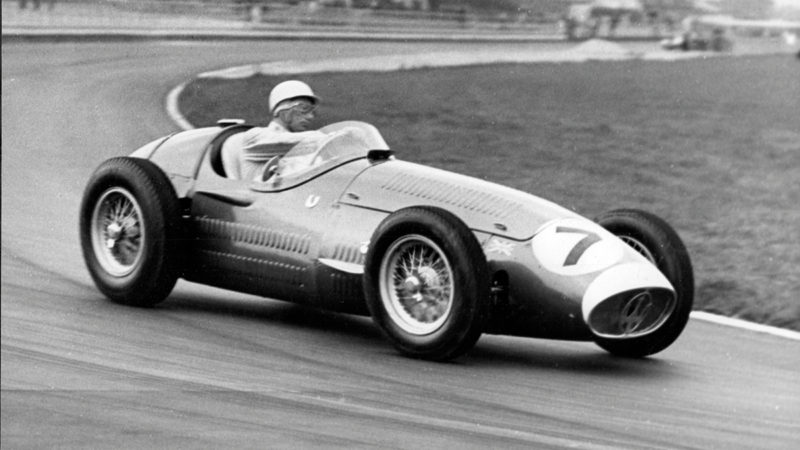Stirling Moss' rise to greatness: a look back at the 1954 Aintree 200 race
The opening of Aintree race track in 1954 was accompanied by a display of virtuosity from a young Stirling Moss in a variety of machinery. Motor Sport editor Bill Boddy was not impressed with the “Manchester weather” but marked the driver out for future greatness

The new motor-racing circuit at Aintree, near Liverpool, opened to a wet but successful International meeting organised by the BARC for the Daily Telegraph on May 29th. The circuit is, with Silverstone, the longest in this country, having a lap distance of exactly three miles. It possesses long straights and a series of interesting bends, is smooth and well surfaced, and the huge and elaborate horse-race grandstands ensure an excellent view. A good deal of mud got conveyed to the course, which, like airfield circuits, lacks definition at the corners. With more bunting and a band it could resemble a continental venue.
The BARC revived its classic 200-Mile Race, but opened it to Formule Libre racing cars, and ran it as two 50-mile heats and a 100-mile final, probably thinking 150 miles was enough for the average English racing car. Continental drivers who braved the dismal “Manchester weather” which enveloped Aintree for practice and the race numbered Jean Behra, André Pilette (Gordinis), P Etancelin (Talbot), Prince Bira (Maserati) and the American driver Carroll Shelby (Aston Martin).
The official figure for attendance is 25,000, and the prevailing enthusiasm was reflected by the dripping umbrellas of spectators who stuck it out on the top of the stands and in the enclosures. They were rewarded by seeing Stirling Moss drive in truly professional style to retrieve lost fortune, his new Maserati winning the Aintree International 200 race and his Beart-tuned Cooper-Norton dominating the 500cc event. Duncan Hamilton took sports car honours in his Type C Jaguar from the brilliant American Shelby in his Aston Martin DB3S and Jimmy Stewart in the ex-Le Mans-winning Ecurie Ecosse Jaguar.
The Christian names “over to you, old boy” PA commentary was open to criticism, because the commentators cracked jokes in the modern slap-happy manner, which we consider in poor taste. Otherwise, bravo Stirling Moss and thank you, Mrs Topham, the circuit owner. Aintree we think, setting aside some purely personal prejudices, has its future in its tomorrows.
The Opening Ceremony
One felt especially sorry that heavy rain was still falling as Earl Howe prepared to ‘break the tape’ of the new Aintree circuit in his immaculate Aston Martin DB2. He addressed the crowds, at first inaudibly due to microphone maladies and then at full blast after he had found the right button — he obviously knows more about accelerators than acoustics.
Mrs Topham also said a few words, remarking “I don’t like this” as she handed the microphone back, and the new circuit, with its Melling Crossing, Tatts Corner, Becher’s Brook Bend, Valentine’s Way and Railway Straight, was open. Motor racing enthusiasts in the Midlands and the North will become familiar with this fine £100,000 circuit but at this opening meeting we are sure many of the spectators expected to see Ken Wharton riding the jumps on Freebooter and Prince Bira leading on Early Mist.

Moss cradles the Daily Telegraph Challenge Trophy. He would go on to score a couple of landmark victories at Aintree, including his maiden F1 World Championship win (for Mercedes, in 1955) and the first all-British WCGP success (sharing a Vanwall with Tony Brooks, in 1957). The full version of the Aintree track remained in use until 1964, but the shorter club circuit is still active for track days and sprint events
Sports Car Race (10 Laps)
This provided a short, sharp curtain-raiser, in heavy rain. The field was interesting, with seven Type C Jaguars, including the three Ecurie Ecosse cars of Stewart, Sanderson and Sir James Scott-Douglas, and Duncan Hamilton’s Le Mans practice car, Salvadori’s Maserati, Chapman’s Lotus, and Carroll Shelby’s Sebring Aston Martin DB3A in American colours.
Stewart led after the initial melée, but Duncan Hamilton sat close behind and Shelby came through the field, driving well. We noticed Protheroe cornering well in his XK120, Gould was seen through the spray having his usual dice in the Kieft, Dickson’s Frazer-Nash had business-like intakes on its bonnet, and Chapman, riding Lotus, fell at Becher’s Brook!
Hamilton’s Jaguar took the lead a few laps from the end, Stewart appearing to miss a vital gear-change. Shelby also passed the Ecurie Ecosse car, and the line-ahead Scottish running was interfered with because Tony Gaze had the HWM-Jaguar ahead of Sanderson and Scott-Douglas, finishing a second behind Stewart and setting fastest lap, at 75.1mph. Duncan certainly pressed on, averaging nearly 74 mph under very wet conditions against Moss’ winning 77.7mph in the F1 car in the Formule Libre race on a dry track, although over three times the distance.
Formule Libre Aintree 200 — Heat 1 (17 Laps)
Any hopes that the rain might cease before the racing cars came out were effectively damped. Three cars non-started, which left Behra’s bIue Gordini, Parnell’s 1953/4 Ferrari,
Moss’ Maserati, Wharton’s stub-exhaust MkII BRM, McAlpine’s, Marr’s, Sir Jeremy Boles’ and Young’s 2-litre Connaughts, Gould’s Cooper-Bristol, Brooke’s HWM, Fairman’s Turner, Hall’s Cooper-Bristol, the aged ERAs of Somervail and Birrell and Peter Collins in the 4½-litre Ferrari Thinwall Special.

Concentration as an art form: Moss rounds Tatts Corner, which was only ever a left-hander at this opening Aintree meeting. The intention had been to run the circuit counter-clockwise, but a decision was taken to reverse its polarity for all future events
Collins, who certainly never seems to recognise when a car is going as fast as it wants to, was expected in some quarters to be wild with all the Thinwall horses at his command. Instead, after a brilliant start he drove this magnificent car splendidly, leading from the first lap, from Parnell, Behra and Moss. Lapping at nearly 80mph in clouds of spray, he built up a truly commanding lead after less than 10 miles. Already McAlpine was in, asking puzzled mechanics to examine the Connaught’s front wheel, which appeared undamaged, and Boles’ Connaught was in trouble.
It looked as if the Thinwall and its new driver would win in a canter, until a change of exhaust note heralded trouble. Parnell’s 2½-litre car had closed right up and on lap 10 passed Collins in front of the pits. Moss was in third place, having taken the Gordini on lap nine, but Collins had sufficient in hand to remain ahead of No7 Maserati. Wharton never got the BRM higher than fifth until lap 10, when he overtook the ailing Gordini.
Formule Libre Aintree 200 — Heat 2 (17 Laps).
Fortified by lunch, the crowd settled down to watch Heat 2. The field consisted of the Belgian Pillete in a yellow Gordini, the Maseratis of Bira and Salvadori, Gaze’s HWM, Tyrer’s massive Bristol-Alta, Thorne and Boulton in Connaughts, Rolt in Rob Walker’s Connaught. Gerard’s Cooper-Bristol, Graham Whitehead’s and Flint’s ERAs (the latter’s being ‘Remus’), Etancelin’s 4½-litre Talbot, the RRA and Flockhart for BRM. Of these, Bira was left with oil running from the front of his car and Gaze was in almost immediately for a plug change, a trouble which dogged him all the rest of the race.

Then aged 24, Moss stands to attention for the post-race National Anthem – and most members of the crowd appear to be doing likewise in the grandstand behind. During his victory speech he mentioned that he would one day like to win in “a green car” rather than one that was “merely painted green”. Little more than three years later his wish would be granted when, with Tony Brooks, he won the British GP at the same venue
Flockhart at once put the BRM at the head of affairs, controlling it like an experienced driver, leading Salvadori and Gerard, going splendidly in his bright green Cooper-Bristol and watched by Joan Gerard. Behind him, Rolt was losing ground, to retire with gearbox trouble. The ERA, too, had a heart-stopping overtaking episode on lap five and also retired, Whitehead called at his pit and Tyrer was lapped by almost the entire field. Bira had started eventually, but was soon back at his pit.
Interest centred on Salvadori’s relentless chasing of the BRM; on lap 12 he was within 3sec of Flockhart and lapping faster, a lap later six lengths behind, then 1½ lengths, and seeming to accelerate nearly as well, suggesting trouble in the V16. Flockhart scraped in to win by 3sec, the order of the leaders unchanged.
500cc Scratch Race (10 Laps)
It was certainly Moss’ day and with his well-known virtuosity he took the Beart Cooper-Norton to the front and ran right clear of the others, winning at nearly 71mph in the wet, and setting an F3 lap record of 72.19 mph. Don Parker held second place and behind Russell was well established as third, but Brandon in Nuckey’s Cooper was engaged in a terrific ding-dong with Hull’s Cooper, ending in Eric’s favour by 6sec. Leston was not present. Incidents included gyrations by Howard and Phillipson at Tatts, engine failure on the part of Harris and Bueb, the disappearance of the Revis as it seemed to be coming into the picture, and a head-on argument with the wall at Anchor Crossing by Graham Maude.
Formule Libre Aintree 200 — Final (34 Laps)
On the grid in the front row were Parnell, Flockhart, Salvadori and Collins, The second row contained Moss, Wharton and Gerard, the third row Pilette, Behra, Etancelin and Hall. Somehow Bira was at the back.
As ‘Ebby’s’ flag began to fall Collins got the Thinwall Ferrari away in the lead ahead of Flockhart’s BRM, and these two led Parnell and Wharton at the end of lap one, Moss fifth.
Collins proceeded to secure a most commanding lead, having the length of the Finishing Straight over the leading BRM after only four laps. Already Parnell had begun to drop back, being passed by Wharton and Moss on lap two. Jean Behra was settling down to some fast work and by lap five Moss was in fourth place, with the Gordini behind him. Then on the next lap Flockhart clipped the straw bales, and fell right back to 11th; Salvadori spun off and went right to the bottom of the cIass.
This made the order of the leaders Collins, racing away on his own, Moss, Wharton, Behra, Parnell, Gerard. Flockhart’s skid was a pointer to BRM discomforts, and on the next lap Wharton waved Behra past as they went into Tatts. The BRM’s brakes were obviously becoming ineffective; Wharton changed down twice before this slow corner, Flockhart three times.
Although Behra was now third, an ominous trail of smoke was corning from the Gordini’s exhaust and when the Thinwall Ferrari began to sound like it had at the end of Heat 1 we realised it was anybody’s race. Moss was driving calmly, stylishly in second place, not appearing to be trying to catch Collins but steadily closing up, with Parnell comfortably far behind after Behra inevitably came to his pit on lap 11.
Meanwhile, Flockhart was making up time and by the 12th lap was in sixth place, behind Gerard’s Cooper-Bristol. But clearly the BRM bolt was shot, for the little Cooper-Bristol kept ahead of the blown V16, a tribute to Gerard’s driving but also an indication that Flockhart had only a part of that world-beating performance left. Back in the field numerous pit-stops did not affect the main issue; Rolt and Birrell retired, Pilette like his team-mate was in trouble, so was Bira, later to resume quite fast, Behra had a second stop, Marr’s Connaught slid into deep mud beside the track, to be restarted by first-aid men. But all eyes were on Collins and Moss. The rain had ceased and the track was dry. Collins would win easily if all his horses continued to prance, but clearly they didn’t wish to.
Lap 13 saw Moss 26sec behind. He had made up two seconds by the next time round; Parnell third, Wharton, Gerard and Flockhart bunched farther back. Lap 17 saw the gap between the leaders unchanged: Flockhart had scraped past Gerard, now fourth and sixth, for Wharton was having a bad time, with Bira behind him with no power to catch up.
Come lap 19 — and Collins pulled in! Plugs were whipped out, new ones put in, the engine proved stubborn to restart, and it was some six minutes before Collins roared back into the race, hopelessly far back, even had the car been fit, which it wasn’t. So Moss became the leader, Salvadori behind him on the road but way back in the race.

Moss in action during practice. Looking back many years later on Aintree’s place in motor sport history, Bill Boddy – author of this report – wrote: “The vast long-standing horse-racing grandstands, restaurants, offices and car parks were a considerable asset, making the facilities for motor racing rather special, if somewhat dour”
Flockhart’s brakes became worse, so that Gerard re-passed him on lap 18, and Etancelin’s Talbot gained on the BRM into Tatts. Hall’s Cooper-Bristol retired with a blown gasket, and Wharton retired, brakes oily and smoking, on lap 22. Moss was going wide into Tatts on his usual impeccable line, lapping now at 77½mph. One commentator asked, “Would he have to refuel?” Quite properly James Tilling said he’d be very surprised if so. And, of course, Stirling didn’t. He just drove on, comfortably in command of Aintree’s first long-distance race.
Stirling Moss, in his victory speech, said that he hoped one day to win in a “green car” and not in one which is “merely painted green.” His last lap was in the back of a Bentley tourer, holding the very impressive Daily Telegraph Challenge Trophy. No win could have appealed more to the rain-soaked English spectators, but, phlegmatic to the last, they scarcely showed it! Moss won £610 in prize money and richly deserved it, even if, like all the true GP drivers, his style is relaxed and unsp